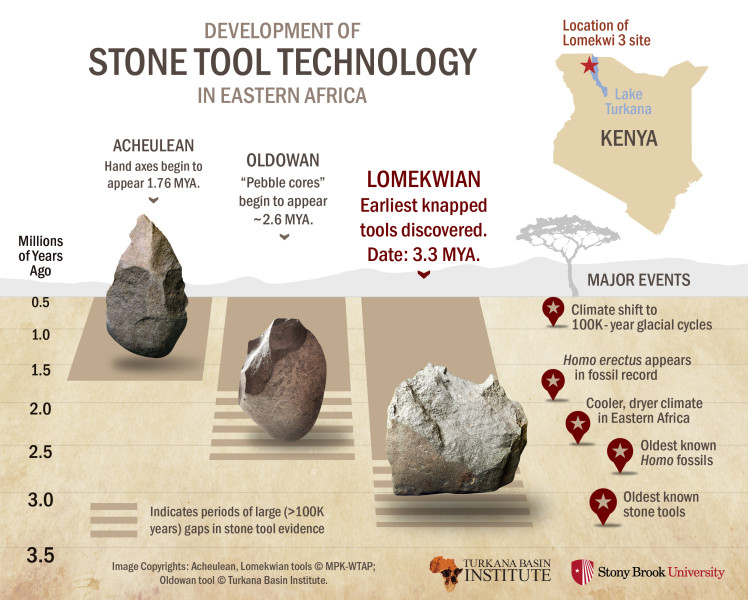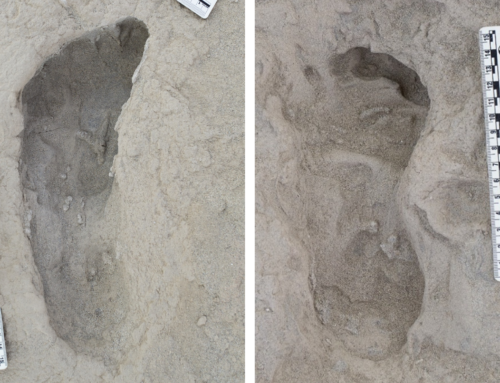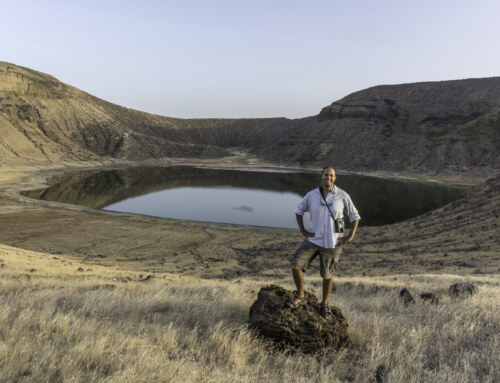The West Turkana Archaeological Project team has found the earliest known stone artifacts, dating to 3.3 million years ago, near the village of Lomekwi (shown on map) in northern Kenya.
Discovery pushes back beginning of the archaeological record by more than half a million years
On the morning of July 9, 2011, Drs. Sonia Harmand and Jason Lewis were climbing a remote hill near the western shore of Lake Turkana in northern Kenya. An hour earlier, they and their team had accidentally followed the wrong dry riverbed, the only way of navigating these remote desert badlands, and they were scanning the landscape for a way back to the main channel. Harmand and Lewis could feel that something was special about this particular place, and so before moving on, they all fanned out and surveyed the patch of craggy outcrops. By teatime, local Turkana tribesman Sammy Lokorodi had helped them spot what they had come searching for.
Video courtesy of Stony Brook University
The West Turkana Archaeological Project team, co-led by Drs. Harmand (with Stony Brook University’s Turkana Basin Institute and the CNRS in France) and Lewis (TBI), had found the earliest stone artifacts, dating to 3.3 million years ago. The discovery of the site, named Lomekwi 3, instantly pushed back the beginning of the archaeological record by 700,000 years, or by over a quarter of humanity’s previously-known material cultural history.
“Stone tools are fossilized human behavior” – Louis Leakey
In the 1930s, famed paleoanthropologists Louis and Mary Leakey unearthed early stone artifacts at Olduvai Gorge in Tanzania, and named them the Oldowan tool culture. Later, in the 60s, when they found hominin fossils that looked more like later humans than the Australopithecines, in association with those Oldowan tools, they assigned them to a new species: Homo habilis or handy man. Conventional wisdom in human evolutionary studies since then has supposed that the origins of knapping stone tools by our ancestors was linked to the emergence of the genus Homo and that this technological development was tied to climate change and the spread of savanna grasslands. The premise was that our lineage alone took the cognitive leap of hitting stones together to strike off sharp flakes and that this was the foundation of our evolutionary success.
Over the last few decades, however, as subsequent discoveries pushed back the date for the earliest stone tools to 2.6 million years ago (Ma) and the earliest fossils attributable to early Homo to only 2.4-2.3 Ma, there has been increasing openness to the possibility of tool manufacture before 2.6 Ma and by hominins other than Homo. A series of papers published in rapid succession in early 2015 have solidified these ideas into an emerging paradigm shift in paleoanthropology: the fossil record of the genus Homo now extends back to 2.8 Ma in the Ethiopian Afar; cranial and post-cranial diversity in early Homo is much wider that previously thought, already evincing several distinct lineages by 2 Ma; and Australopithecus africanus and other Pleistocene hominins, traditionally considered not to have made stone tools, have a human-like trabecular bone pattern in their hand bones consistent with tool use.
Now, the Lomekwi artifacts show that those ideas are correct and at least one group of ancient hominin started intentionally knapping stones to make tools long before previously thought. These new archaeological finds are yet another paradigm-shifting discovery from the Lake Turkana basin, which has been made famous over the past five decades through the work of the second and third generation of the Leakey family: Richard, Meave and their daughter Louise, and has produced much of the world’s most important fossil evidence for human evolution. The Lomekwi area where the tools were found had already produced the fossil skull of early hominin Kenyanthropus platyops by Meave and her team, and the West Turkana Archaeological Project has previously discovered the earliest artifacts from the Oldowan culture known from Kenya, and the world’s oldest Acheulean handaxes.
“These oldest tools from Lomekwi shed light on an unexpected and previously unknown period of hominin behavior and can tell us a lot about cognitive development in our ancestors that we can’t understand from fossils alone” said Dr. Harmand, the lead author of the paper published in the journal Nature announcing the discovery. “Our finding finally disproves the long-standing assumption that Homo habilis was the first tool maker,” she added.
Furthermore, the team found that these tools are unique compared to the ones known from after 2.6 million years. “The stones are much larger than Oldowan tools, and we can see from the scars left on the stones when they being made that the techniques used were more rudimentary, requiring holding the stone in two hands or resting the stone on an anvil when hitting it with a hammerstone. The gestures involved are reminiscent of those used by chimpanzees when they use stones to break open nuts ” said Dr. Harmand. Their study of the Lomekwi artifacts suggest to them that they could represent a transitional technological stage, a sort of missing-link, in between the pounding-oriented stone tool use of a more ancestral hominin and the flaking-oriented knapping behavior of later, Oldowan toolmakers.
The team was also surprised to find that reconstructions of the environment around Lomekwi at 3.3 million years ago, from the associated animal fossils and isotopic analyses of the site’s soil, indicate the area was much more wooded than paleoenvironments associated with later East African artifact sites from after 2.6 million years. “The Lomekwi hominins were most likely not out on a savanna when they knapped these tools,” said Dr. Lewis.
While it is tempting to assume that these earliest artifacts were made by members of our genus Homo, the team urged caution. “Is it extremely rare to be able to pinpoint what fossil species made which stone tools through most of prehistory, unless there was only one hominin species living at the time, or until we find a fossil skeleton still holding a stone tool in its hand” said Dr. Lewis.
The Lomekwi 3 discovery raises many new challenging questions for paleoanthropologists. For one, what could have caused hominins to start knapping tools at such an early date? “The traditional view was that hominins started knapping to make sharp-edged flakes so they could cut meat off of animal carcasses, and maybe used the cores, called ‘choppers’, to break open bones to get at the marrow” Lewis says. “While the LOM3 knappers certainly created cores and sharp-edged flakes, their size and the battering marks on their surfaces suggest they were doing something different as well, especially if they were in a more wooded environment with access to various plant resources.” The team thinks the tools could have been used for breaking open nuts or tubers, bashing open dead logs to get at insects inside, or something not yet thought of. Dr. Lewis is helping lead experimental work to help reconstruct how the tools were used.
Another unknown is what’s happening archaeologically between 3.3 and 2.6 Ma. “We’ve jumped so far ahead with this discovery, we need to try to connect the dots back to what we know is happening in the early Oldowan” Harmand says.
Of course, the most intriguing question is whether even older stone tools remain to be discovered. “I have no doubt that these aren’t the very first tools that hominins made” Dr. Harmand said. “They show that the knappers already had an understanding of how stones can be intentionally broken, beyond what the first hominin who accidentally hit two stones together and produced a sharp flake would have had. I think there are older, even more primitive artifacts out there.”
Additional Media
View the stone tools in interactive 3D at AfricanFossils.org
More coverage
Stony Brook University: Stony Brook Archaeologists Find the Earliest Evidence of Stone Tool Making in Cradle of Humankind
New York Times: Stone Tools From Kenya Are Oldest Yet Discovered
NBC News: Oldest Stone Tools Go Back 3.3 Million Years, Predating Our Species
Huffington Post: Discovery Of World’s Oldest Stone Tools Overturns Traditional View Of Early Humans






